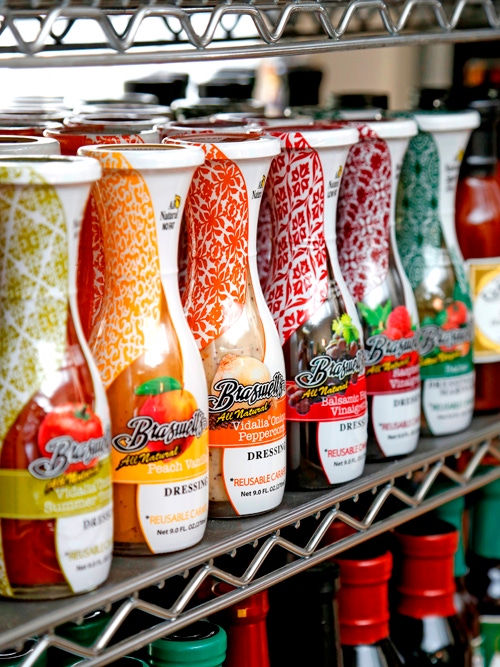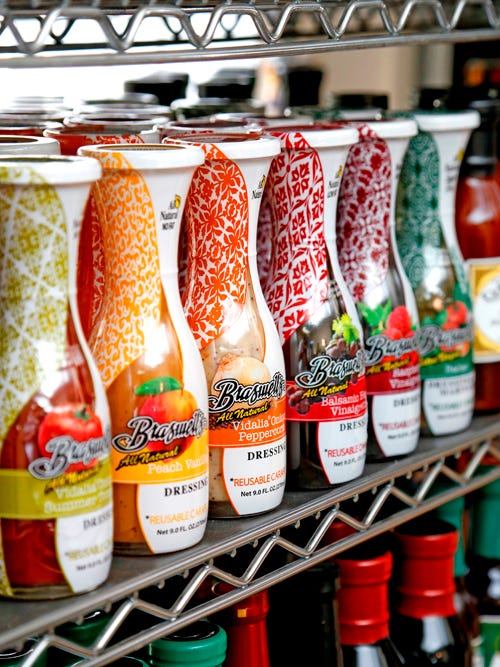Dressing up and stepping out
March 11, 2015


Braswells carafe on shelf
A.M. Braswell Food Co. wanted to improve its salad dressing, but it needed some new ingredients on its packaging line.
The privately owned company, based in Statesboro, GA, produces dressings, as well as jellies, jams, condiments, sauces and other products, both under its own brand and for private label. Braswell's wanted to transition to full-body shrink labels on the glass carafes it uses for a line of dressings. The labels extend to the top of the closure for tamper evidence and feature a transparent panel that allows the product to show through. But Braswell's didn't have the right equipment to apply a label like that-and, initially, didn't think it could find it at the right price.
Braswell's had been using simpler packaging with the carafes.
"We had that particular jar with just a label on the back side and a hang tag before we decided that we wanted to go to a full-body sleeve as an alternative," says Frank Farr, Braswell's co-owner and operations manager. "But that was pretty cost- and labor-intense. Also, we had mixed feelings from our customers-some private-label customers versus grocery customers. We were looking for more pop on the grocery shelves."
Farr explains that there were other items that he wanted to label with a full-body sleeve. But the company didn't have the equipment and, at the time, the film was not clear enough.
"Eventually, we found a suitable film, and that rekindled our interest in a full-body shrink label for the carafes. The film appears more transparent and we feel that is important for the customer to get a good visual of the product through the window of the bottle," Farr says. "I believe the shrink film industry seems to have more to offer now in color and shrink consistency for a full-bodied sleeve application than ever before."
Production personnel managed to adapt the existing T-E band applicator to the full-body labels, but "with the sales potential that we're experiencing with these carafes, there's no way it could have kept up with production [demand], so we had to up the ante," Farr says.
That meant finding a new machine. But Braswell's could not initially find equipment at the right price.
"We were kind of testing the market with the product, as well as waiting for a machine to be available at a price point that we were willing to pay," Farr says. "I was looking at several different options, but they were just priced way out of where I wanted it to be."
Then company president Andy Oliver went to the Pack Expo show last fall in Chicago and spotted a machine of interest in the booth of NAFM LLC. It was the Model LX-150SP, a medium-speed, in-line shrink-sleeve labeler.
"Oliver was the third person who walked by our booth as soon as the show opened," says Dave Denn, manager of sales and service at NAFM. "He actually stopped in his tracks and came back and said, ‘Who are you guys?'"
The LX-150SP is fully servo-driven and is equipped with a dual unwind system for continued operation with brief splicing stops. A roll of material is pulled onto a floating bullet (mandrel) by a set of drive rollers and driven by a servomotor. The drive rollers accurately and intermittently advance the label material, controlled by a photoelectric sensor reading each impression.
A set of six rotating blades cut the label as it stops momentarily on the bullet, then drive rollers slide the label further down onto the container. At this point, the label is in specific shape given by the bullet (mandrel), and aligned precisely to the container, with the help of a timing screw or a spacing wheel, for smooth transfer. An optional label brush-down device can be used for certain types of containers, to make sure that the bottoms of the labels are flush against the conveyor surface.
Braswell's decided just before Christmas of last year to buy the LX-150SP, becoming one of NAFM's first end users for this model.
"We had the [equipment] up and running from nearly the first day," Farr says. Braswell's had sent NAFM all the bottle sizes it planned to run on the new equipment, and it came to the plant with those parameters preprogrammed. In addition to labeling the dressing carafes, the machine puts T-E bands on other products.
The LX-150SP's microprocessor controls are accessed through a touchscreen panel, helping make changeovers quick and easy. Label cut length can be altered by a simple screen command. Containers of different diameters can be processed with changeovers of the timing screw and mandrel, while different heights can be accommodated by raising or lowering the machine through a simple turn-screw adjustment.
The LX-150SP is rated for a maximum speed of 300 bottles per minute. Braswell's is currently running its model in the range of 100 to 110 bpm; Farr says that will reach 140 bpm once the company installs a larger accumulation table and a few more case packers downstream. Its fillers will be able to handle the extra capacity.
For now, Braswell's will continue to use its existing shrink tunnel, which uses radiant heat. Farr is interested in eventually switching to a steam-heat tunnel, because it offers more flexibility: The nozzles that emit the steam can be adjusted to hit a given container in just the right spots for optimal label fit. The drawback is that steam means moisture, which can be a problem in other spots on the packaging line.
The new label opens up marketing potential for Braswell's salad dressing—one of its major products—under both its own brand and private label. The full-body label provides the visual "pop" that shrink labels can furnish at a fraction of the cost of decorated containers. A portion of the label is transparent, providing a vertical "swirl" through which consumers can view the dressing for added "appetite appeal." Farr says this will meet Braswell's need for containers with more visual impact, and open the door to more products with full-body labels.
About the Author(s)
You May Also Like


